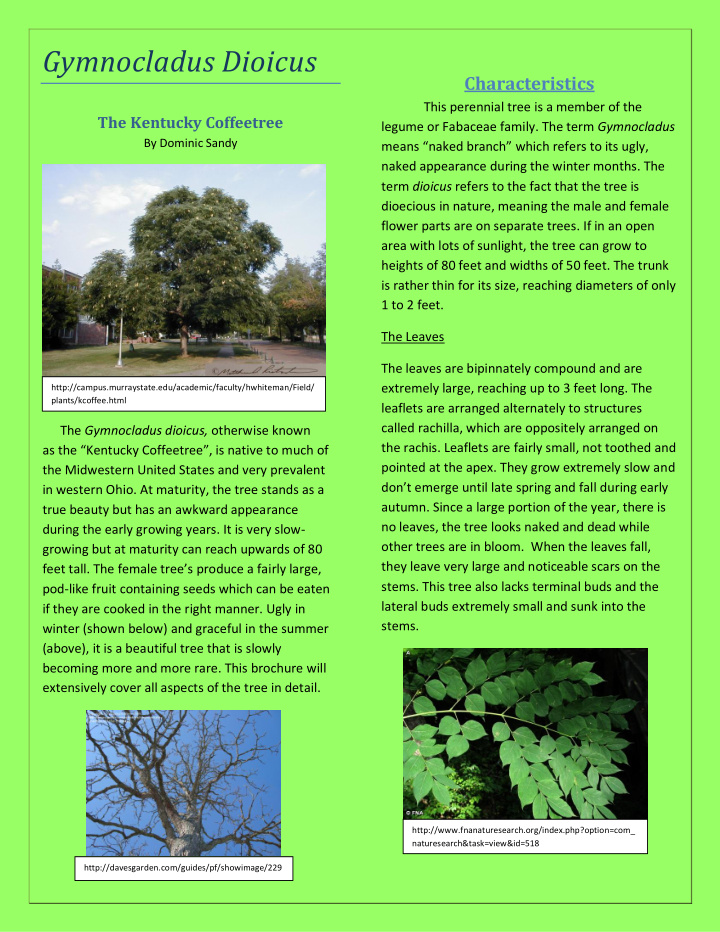



Gymnocladus Dioicus Characteristics This perennial tree is a member of the The Kentucky Coffeetree legume or Fabaceae family. The term Gymnocladus By Dominic Sandy means “naked branch” whi ch refers to its ugly, naked appearance during the winter months. The term dioicus refers to the fact that the tree is dioecious in nature, meaning the male and female flower parts are on separate trees. If in an open area with lots of sunlight, the tree can grow to heights of 80 feet and widths of 50 feet. The trunk is rather thin for its size, reaching diameters of only 1 to 2 feet. The Leaves The leaves are bipinnately compound and are extremely large, reaching up to 3 feet long. The http://campus.murraystate.edu/academic/faculty/hwhiteman/Field/ plants/kcoffee.html leaflets are arranged alternately to structures called rachilla, which are oppositely arranged on The Gymnocladus dioicus, otherwise known the rachis. Leaflets are fairly small, not toothed and as the “Kentucky Coffeetree”, is native to much of pointed at the apex. They grow extremely slow and the Midwestern United States and very prevalent don’t emerge until late spring and fall during early in western Ohio. At maturity, the tree stands as a autumn. Since a large portion of the year, there is true beauty but has an awkward appearance no leaves, the tree looks naked and dead while during the early growing years. It is very slow- other trees are in bloom. When the leaves fall, growing but at maturity can reach upwards of 80 they leave very large and noticeable scars on the feet tall. The female tree’s produce a fa irly large, stems. This tree also lacks terminal buds and the pod-like fruit containing seeds which can be eaten lateral buds extremely small and sunk into the if they are cooked in the right manner. Ugly in stems. winter (shown below) and graceful in the summer (above), it is a beautiful tree that is slowly becoming more and more rare. This brochure will extensively cover all aspects of the tree in detail. http://www.fnanaturesearch.org/index.php?option=com_ naturesearch&task=view&id=518 http://davesgarden.com/guides/pf/showimage/229 638/
Versatility The Flower and Fruit The Kentucky Coffeetree has a variety of uses, both past and present. In the past, Native Americans used the pulp, leaves, seeds and bark from the tree both medicinally and for food. The pulp, seeds and bark were used by Native Americans for a variety of natural medicines. Some tribes also used the seeds for food, by roasting them. In the early years of our country, pioneers often used the seeds of the tree as a substitute for coffee although it lacked caffine. http://www.flickr.com/photos/mightyjoepye/5702107663/ Since everything else about this tree is slow- growing, you should have guessed by now that the flowers are too. They tend to not appear until late spring and are rather small. Often people do not even notice that the flowers are present on the tree because of their size. They are white petals with a greenish hue http://lumberjocks.com/projects/69926 to them. On male trees, the flowers are shorter but they appear more often, while female trees have longer Today, the most common uses for the tree are flowers but there are fewer of them. for lumber and soap. This species is pest and disease The flowers on female trees produce a tough, free which allows for the trees survival and so is often inedible fruit pod that splits open to reveal several used for a variety of carpentry activities. The fruit is also seeds. These pods start out green but will eventually used in making some commercially sold soap. Due to its turn a dark brown. Because the pods are so tough, they decreasing numbers, it is not often used in decorating tend to stay on the tree way into winter, even early cities or suburban front yards but is still prevalent in spring of the next year. The pulp and seeds tend to go some areas. The other obvious use for the tree is as a untouched by animals because they are toxic and wood fuel source. poisonous to animals. However, the seeds can be The Kentucky Coffeetree has its uses, but the consumed if they are cooked to a proper temperature. tree is slowly disappearing and so it is wise to respect Native Americans once used the seeds and pulp of the the tree and be mindful of the affects uses will have on fruit both medicinally and as food. the species as a whole. References http://ohiodnr.com/forestry/trees/coffeetree_k y/tabid/5355/Default.aspx http://wcisel.com/plants/kentuckycoffeetree/in dex.htm http://www.library.uiuc.edu/vex/toxic/kentuck y/kentucky.htm http://treehunter.info/Alternate/cassia/kentuckycoffeetree/ kentuckycoffeetree.htm http://plants.usda.gov/plantguide/pdf/cs_gydi. pdf http://www.cas.vanderbilt.edu/bioimages/image/g/gydi-- frseeds24261.htm
Recommend
More recommend